
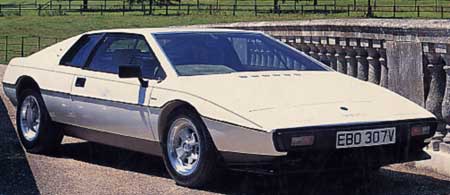
BUYING SECONDHAND:
Lotus Esprit
This is a Buying Secondhand survey which will interest almost every reader, but be truly useful to only a limited number, mainly because of the scarcity of the cars involved. No matter. Every one of us, surely, has wanted to own a sleek, mid-engined, specialist sports car at least once in our motoring lives? In the case of the Lotus Esprit, and particularly the older examples, this need not be financially out of the question, even though there are several serious caveats we should spell out along the way.
The Esprit was the second mid-engined Lotus road car design (the Europa of 1966-75 was the first), and it is still a current model, in production at Hethel. It makes no claims to be other than what it looks like - which is to say that is a strict two-seater, with fast motoring in mind, and few concessions to load carrying, or family car convenience. There fast Esprits, and very fast Esprits. All look similar, all have (or should have) staggeringly high standards of roadholding, and all are guaranteed to grab attention wherever they go.
But there is a snag. To buy, run, maintain and insure a car of this type requires a great deal of money. An Esprit should not be bought on a whim, or as an indulgence, unless your pocket is deep indeed. Competitors? The Esprit has few, though in view of its performance and specification one would have to consider the mid-engined V6 and V8 Ferraris (246 and 308 variety), the Porsche 911 in some forms, and perhaps even the Lancia Monte Carlo. The field is limited - but then so is the market. It makes a fascinating subject in this series.
The three series of Lotus Esprit.
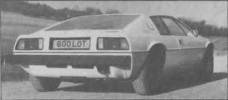
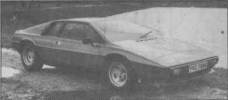
Left: 600 LOT is a Series 1
model
Right: Series 2
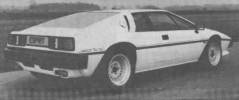
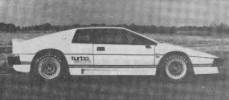
Left: The distinctive 3 Series, with
the word Lotus moulded into the rear bumper.
Right: Above is the Turbo Esprit. Apart from
the lettering, it can be recognised by its rear spoiler and sill air scoops.
DEFINING THE PEDIGREE
Like almost every modern Lotus road car (and the De Lorean DMC 12, in which Lotus had a major part in the development) the Esprit has a steel backbone chassis frame, with coil spring independent front and rear suspension, rack and pinion steering, wide-rim cast-alloy wheels and fat VR-rated radial ply tyres. There are variations between Esprit derivatives, but the suspension and wheel/tyre specifications are virtually the same for all types.
The engine is Lotus' own, being a light-alloy slant-four, with twin overhead camshafts and four valves per cylinder, mid-mounted behind the passenger compartment, driving the rear wheels through a specially-adapted five-speed all-synchromesh gearbox.
All Esprits have four wheel disc brakes, servo assisted, and all have the same basic type of wedge-nosed two-seater coupé body style, constructed in glass fibre.
The original car was put on sale in mid-1976, since which time there have been four distinctly different types of normally-aspirated Esprits, and the amazingly fast Turbo derivative. The Esprit shares some components with other (front-engined) Lotus models - the front suspension and the engine being the most obvious - and it shares the same philosophy as the other cars. Lotus withdrew from the kit car market some years ago before the Esprit came on to the scene, so all Esprits were fully assembled at Hethel, near Norwich.
Although Lotus have new models on the way, they insist that the mid-engined Esprit, and further developments on the basic theme, will be on the market for some years to come.
ENGINES
Lotus developed their own new engine design for the 1970s and 1980s, which owes nothing to any other unit (unlike their previous Twin-Cam, which was based on a Ford bottom-end). It has a light-alloy cylinder block, and head, with twin overhead camshafts, four-valve per cylinder, and cogged belt drive to those cams. British and European specification cars have twin horizontal dual-choke Dellorto carburettors, though US specification "Federal" versions have twin Zenith-Strombergs instead. It is worth noting, not only that this engine is also found on the Elite, Eclat and Excel models, but in the Jensen-Healey, and the Talbot Sunbeam-Lotus hatchback, with important specification differences in each case.
Esprit S1 and S2 models both used a 1,973 c.c. version of the engine, while the S2.2, S3 and Turbo all use the re-developed, longer-stroke, 2,174 c.c. version in its place. The two types are almost identical in outward appearance. Both the normally aspirated types are rated at 160 bhp peak output, but the 2.2 has rather more peak torque (160 lb.ft.) and is therefore more meaty and flexible.
The Esprit Turbos all have 2,174 c.c., and are amazingly powerful and flexible, with 210 bhp, and no less than 200 lb.ft. maximum torque. The original Essex commemorative-liveried Turbos had a dry sump lubrication system, but from 1983 all Turbos reverted to a wet sump, like the normally-aspirated cars.
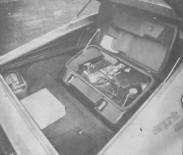
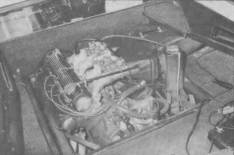
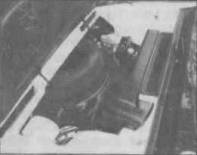
Left: Immediate access to the engine is limited,
with just enough room to get at vital service points
Centre: For majot servicing, the whole engine cover has to be removed; even
then, access is still restricted
Right: There is some room in the front for squashy luggage around the spare
wheel and servo unit
TRANSMISSION
This section is short, and easy to write. All Esprits, of all types, use the same all-synchromesh five-speed manual gearbox/transaxle, which is usually said to be that of the Citroën SM, but which (in view of the way it is installed in the car, behind the engine) is more properly called a Maserati Merak gearbox. It was designed by Citroën to look after as much power as any Esprit has ever yet produced, and is now only produced for this car to use. The gear-change is between the seats, and real miracles of packaging have been needed to thread the linkage around the engine, and transfer movements to the rear of the car.
MODEL EVOLUTION
We will deal with normally aspirated cars first. The original Esprits was announced in October 1975, but did not go on sale until June 1976, and was a 1,973 c.c. machine, with Giugiaro styling, Wolfrace wheels, and a separate front spoiler. Like all other Esprits, of course, the headlamps were hidden behind flaps on top of the nose, there were fuel fillers on each side of the car, and the luggage space was a compartment behind the engine and on top of the transmission, with virtually no space up front. Experience had shown that this was not a very reliable car.
The Esprit 2, announced in summer 1978, had slightly revised styling, with an integrated front spoiler, air intake "ears" behind the side windows, and Speedline road wheels, plus a lot of attention to trim and build quality, though the mechanical specification remained the same. The most short-lived Esprit of all was the S2.2, sold from spring 1980 to spring 1981. It had the enlarged 2,174 c.c. engine, a strengthened drive line and suspension, with the original chassis now galvanised for extra long life.
Then came the S3, still the current model, which benefited not only from the Turbo's new chassis frame (with room for the still unused V8 engine which Lotus admit to be coming, one day), and the option of 15in. Turbo wheels and tyres, but also Goodyear NCT tyres, and a great deal of detail development.
Finally there is the Esprit Turbo, announced as the Essex Commemorative version early in 1981, and still a current, and important, model. This had the 210 bhp turbo charged engine, and the new galvanised chassis frame, with revised rear suspension including transverse top links and plunging drive shafts, instead of the earlier-specification fixed-length shafts doubling as top links. All turbos have 15in. diameter BBS wheels, and fat section tyres, and all have large rear spoilers, louvred engine covers, and vented skirts along the sills between the wheels.
Over the years there have been other "special editions" including cars decorated in JPS livery to celebrate the 1978 World Championship, though these have never featured mechanical changes. All Esprits have radios, but only the Essex Turbos had a complex Panasonic FM radio system mounted in the centre of the roof panel.
In every case, an Esprit had two sharply reclined seats, widely separated by the high and wide chassis cover, with podded instruments all ahead of the driver, and with the handbrake lever burried in the door sill outboard of the driving seat. All Essex cars had air-conditioning, and may other Esprits have had it fitted as an option.
By the end of 1982, production totals (and UK deliveries) for Esprits as are follows:
| Esprit S1 Esprit S2 Esprit S2.2 Esprit S3 Esprit Turbo |
Total 718 1,060 88 306 378 |
UK (205) (523) (75) (259) (260) |
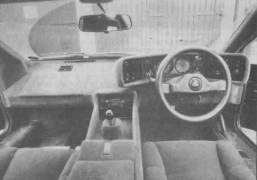
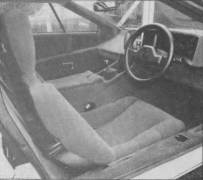
The instrument panel is a deep, wrap-round unit, sitting on top of the main facia; the handbrake is set into the side sill, just ahead of the ashtray; the seats provide ample lateral support
AVAILABILITY AND CHOICE
firstly, note that there are only 76 Lotus dealers in the UK, and anyone considering buying an Esprit should make sure that they are within sensible range of one of them. The car (its engine in particular) is complex enough for no other garage really to be trusted with its upkeep. This is an important factor.
Naturally enough the choice is limited, especially as a good number of the S1 cars have now been written off, or deteriorated beyond reasonable repair. We would only recommend a Turbo to someone who can honestly keep it in the manner to which it should be accustomed. Of the others, we advise buying a 2.2 litre car (S2.2 or S3) in preference to the others, not only because they are more up-to-date, but because the engines are more torquey and flexible. However, our test figures show that S1 and S2 cars can be very fast, but you should be prepared to spend large sums on them to get them back in good condition - or pay through the nose for a well-loved example.
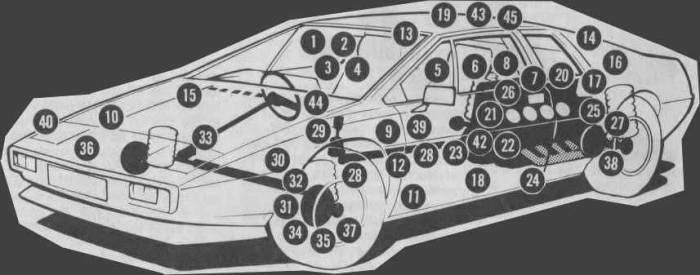
WHAT TO LOOK FOR
Above all, in the case of the Esprit, you must look carefully at its overall condition, and its service record (1), and we also think it wise to enquire about the number, and description, of previous owners (2). A neglected Esprit can become very rough indeed. try to discover even how much routine maintenance cost (3), never mind obsessive work, and try to get an independent report on the car's condition before buying it (4) - which means someone who knows Esprits, but is not involved in the sale. In addition, be sure to ask if the car has ever been involved in an accident (5), for this may have damaged the chassis frame, or the body shell. Be sure, too, before you agree to buy, that your insurance company will still be talking to you afterwards (6).
BODY
Even the older cars (S1 and S2) should still have good body shells, showing no more than local GRP crazing around stress points like door handles (7), filler caps (8), and other hinge points (9). There can be no corrosion, of course, and Lotus's moulding techniques are far too advanced to allow shredding. If there is minor damage to a panel, or to a "corner", do not despair, for Lotus dealers can supply small, large, or even very large sections, short of a complete body shell (10).
On well-used cars, there may be some door dropping (11), which is caused by worn pins, and can be rectified in a matter of hours. These pins, incidentally, tend to seize after a long time (12), so check up for this when the doors are being opened.
There may be some water leakage around the screen or the backlight glasses (13, 14), which is usually caused by the original bonding giving up the ghost. Repair by adding rubberised "gunge" is not a proper cure - expensive rebonding should be done instead. There should be no other leaks especially into the front compartment (15) or the boot area behind the rear wheels (16). That boot area, incidentally, may get quite hot, but should not be polluted by engine fumes unless the engine bay cover seals have perished (17). There are no obvious wear points on the shells, but noise and engine fumes may percolate through into the cokpit if the integrity of the bulkhead has been disturbed (18); repair to the glassfibre, where necessary, cures that one.
Trim for early S1s may no longer be available, but most other derivatives are well covered. We think, incidentally, that a "Special Edition" Gold Leaf model of 1978/79 is well worth having, and premium prices are usually asked. Essex commemorative models, by the way, are not as popular, as the colouring is somewhat garish and obstrusive (19).
MECHANICAL
The biggest worry should be reserved to the engine, which is magnificent if well cared for, an expensive liability if neglected. Look for out-of-balance carburettors (20), oil leakage from cylinder head joints (21), and excessive valve gear (tappet) noise (22) as signs of this. The tappets must be adjusted at 10,000 miles intervals, and the cam drive belt every 25,000 miles; this is not cheap (23). You may also notice that the exhaust manifold is cracked (24), and that there is some sign of water/oil mixing due to previous neglect, and damaged head gaskets (25).
the engine may lose oil through faulty joints, but not use much (26), unless the cylinder bores and the valve guides are badly worn. You will get a feel for condition by general noise levels, fuel consumption, and the overall "balance" of the carburation.
The citroën-made gearbox is good and strong, but occasionally what sounds like noisy clutch release bearing may be worn input shaft (27), and sometimes there are oil leaks from the selector cross shaft bushes (28). Do not be too alarmed, by the way, if the gear linkage is sloppy (29), for this may only be due to worn bushes in the long linkage, not in the gearbox internals.
The clutch is well on top of its job, even in the turbo.
The chassis frame should not be showing signs of serious corrosion, even on early cars (30), though have a look at the front cross "T" member to make sure. Later cars, with galvanised frames, should be safe for many years. Front suspension "sealed for life" joints sometimes start to squeak and be extruded (31) and the dampers really don't last much beyond 30,000 miles (32); replacement by Konis is recommended. The steering is fine, if the gaiters are not split, but look for worn steering column U/Js which make the steering notchy (33), and which are costly to replace. Lower ifs balljoints, too, occasionally give trouble (34).
At the rear, the same remark applies to the dampers, and to bushes in the lower wishbones (35). Be sure, too, that the toe-in settings are correct - check this by having someone follow you on a test drive, looking for straight-running behaviour (36). Rear U/Js wear, and need greasing religiously every 5,000 miles - the signs are clonking noises, and deteriorating roadholding on pre-S3 cars.
In general, the brakes are good, if well maintained, but worry about Bundy tube corrosion on early examples (37), a tendency of rear disc calipers to seize after a salty winter (38), and for the handbrake to be sloppy and out of adjustment.
In general, the performance of Lotus electrics is much better than it was 10 years ago, but be sure things like headlamp lift motors (40), and all the instruments (41) are working properly. For peace of mind, we recommend that you have the engine ignition HT settings and adjustment carefully checked (42).
A word about the Turbo Esprit. This is a Supercar, and should be treated as such. Expect it to cost a small fortune to run - at least to run properly - and you will not go far wrong. Engine and transmission reliability, however, appears to be good. We would, incidentally, recommend the purchase of a plain-colour example, rather than an "Essex" (43), for its resale value will be higher, and we always recommend finding a car fitted with air-conditioning (44). Above all, remember that although you may be able to afford to buy the car, the price of some parts is quite horrifying, and service sometimes takes a lot longer than with more conventional sporting cars (45). You should consider how far away a qualified Lotus dealership is - on no account let strangers attempt to maintain the complex 16-valve engine.
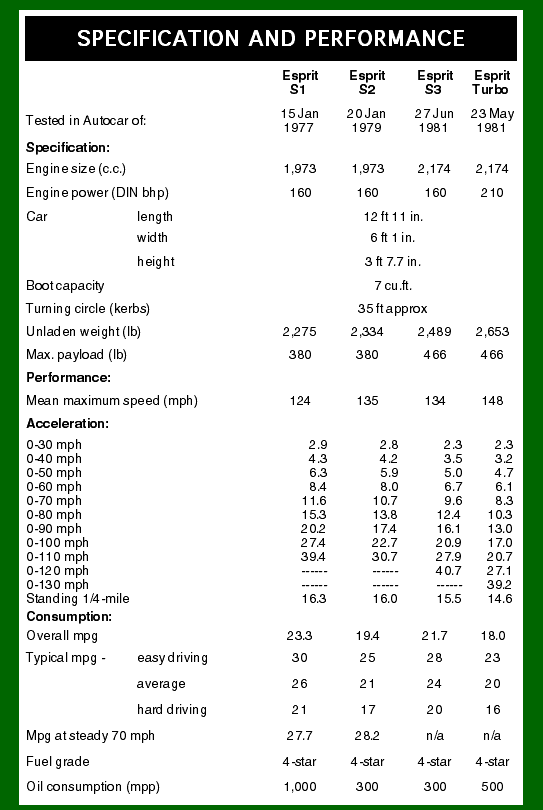
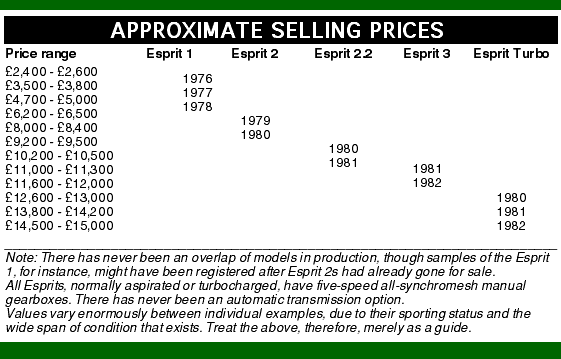
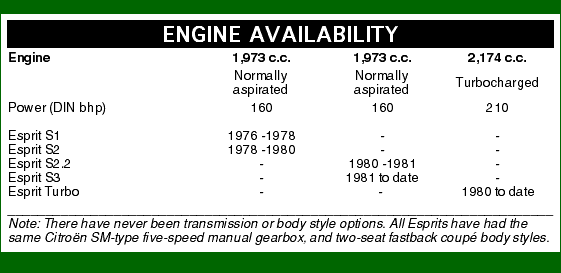
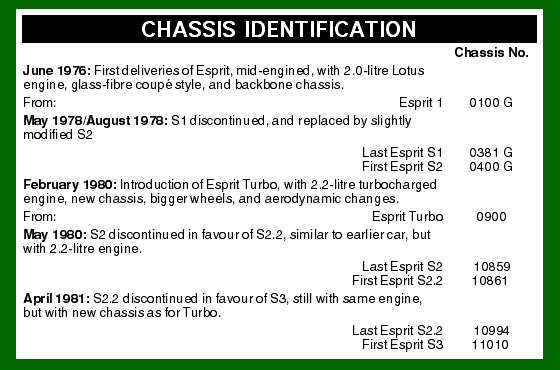
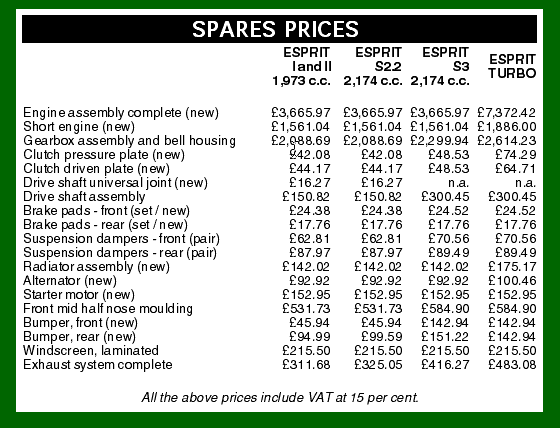
|
|